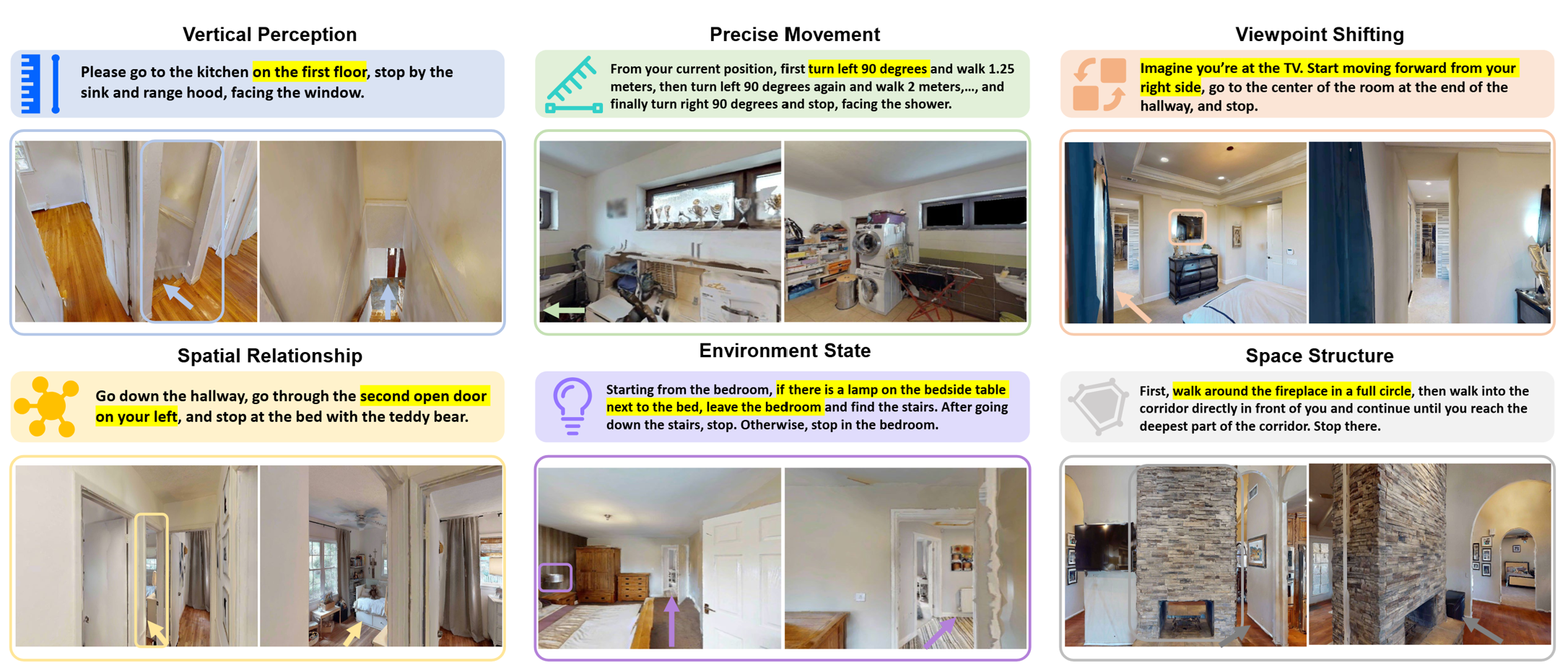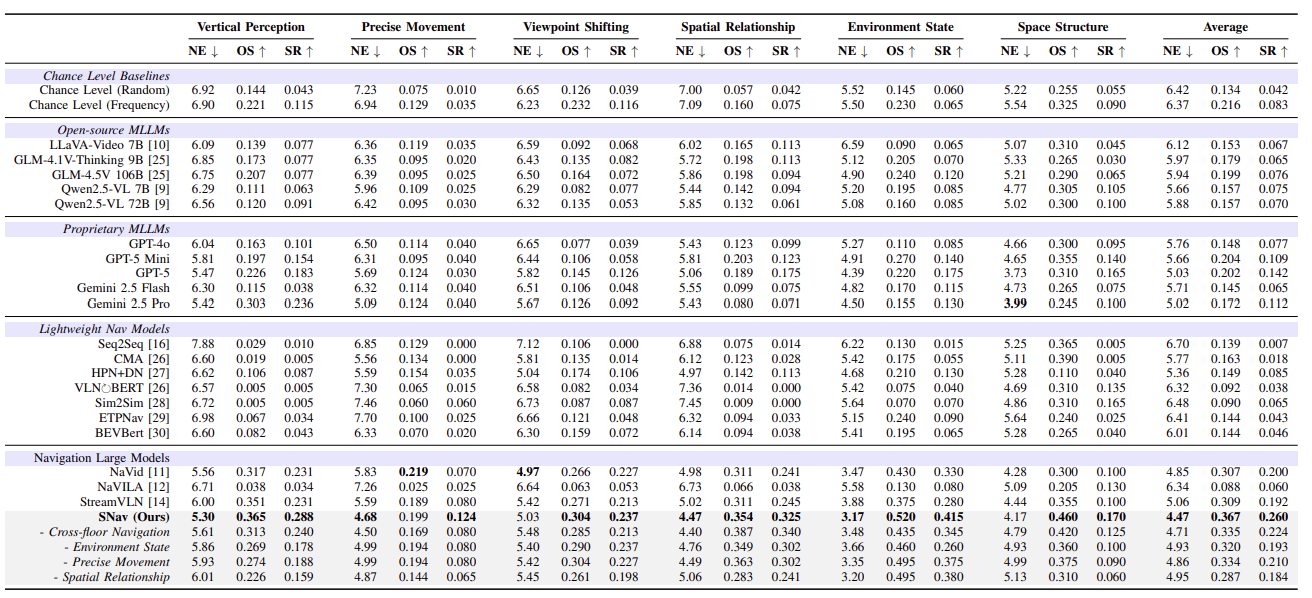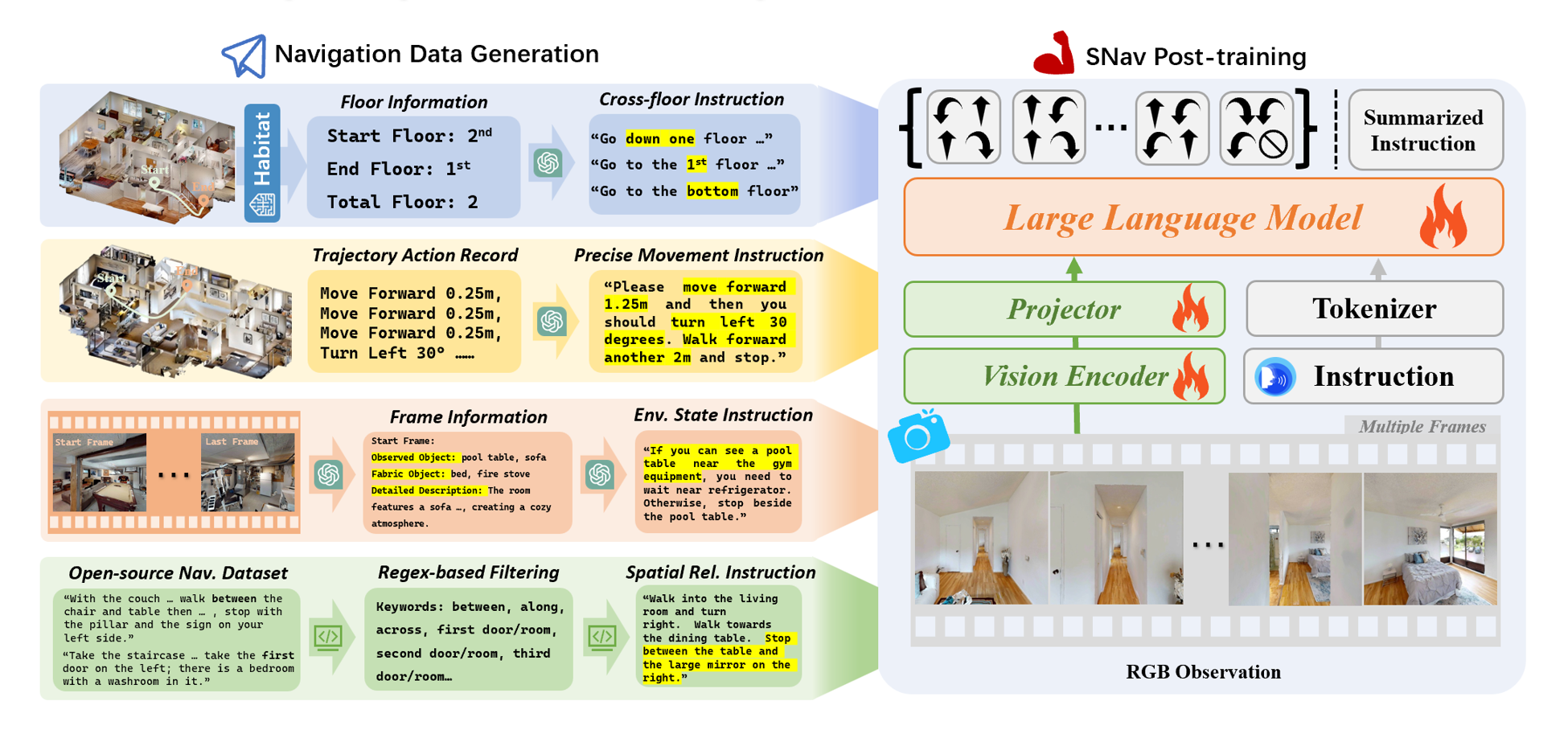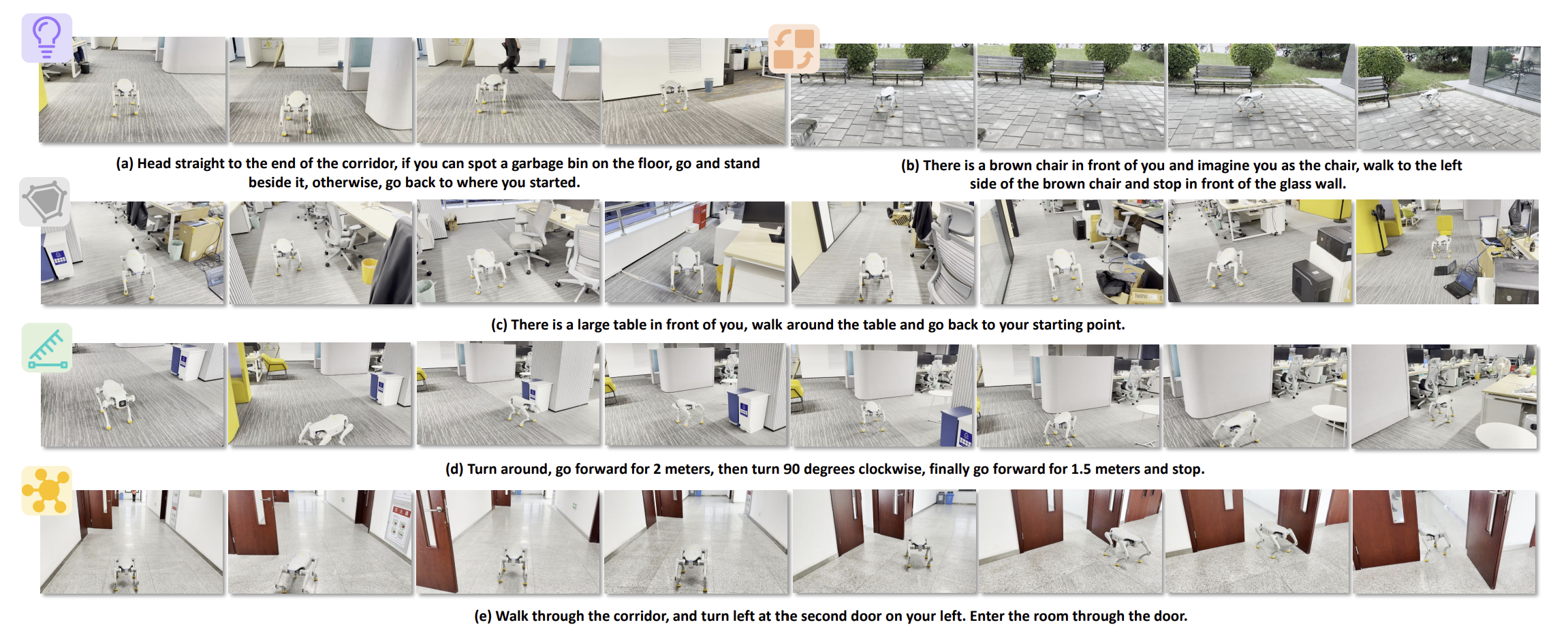NavSpace
How Navigation Agents Follow Spatial Intelligence Instructions


![]() Click to jump to each section.
Click to jump to each section.
NavSpace: How Navigation Agents Follow Spatial Intelligence Instructions

Benchmark Overview: We introduce the NavSpace benchmark, which contains six task categories and 1,228 trajectory-instruction pairs designed to probe the spatial intelligence of navigation agents. On this benchmark, we comprehensively evaluate 22 navigation agents, including state-of-the-art navigation models and multimodal large language models. The evaluation results lift the veil on spatial intelligence in embodied navigation. Furthermore, we propose SNav, a new spatially intelligent navigation model. SNav outperforms existing navigation agents on NavSpace and real robot tests, establishing a strong baseline for future work.


NavSpace Construction: We designed a two-part survey to identify navigation instructions indicative of spatial intelligence. Participants first reviewed a definition of spatial intelligence and confirmed comprehension, then evaluated 17 candidate instruction types, selecting up to six. From 512 responses, 457 valid ones were retained, yielding six key categories: Vertical Perception, Precise Movement, Viewpoint Shifting, Spatial Relationship, Environment State, and Space Structure. To collect trajectories, we built a Habitat 3.0-based platform with HM3D scenes, integrating a front-end annotation webpage and simulator-linked backend. Annotators teleoperated agents in first-person view, recording RGB frames, actions, and coordinates. GPT-5 then analyzed trajectories, combining navigation data with sampled visual observations to generate candidate instructions, which annotators refined and finalized. For quality assurance, cross-validation required each instruction to be executed by a different annotator; unsuccessful cases were discarded and re-annotated. This pipeline ensured collected data were diverse in spatial reasoning and reliable for downstream evaluation.

Figure 4: Construction pipeline of NavSpace. (1) Questionnaire Survey: identify navigation instruction types that best reflect spatial intelligence. (2) Trajectory Collection: teleoperate agents in simulation to record trajectories. (3) Instruction Annotation: generate instructions with large-model-assisted analysis. (4) Human Cross-Validation: review and validate instructions for correctness and executability.
Evaluation Environment and Metrics: NavSpace takes Habitat 3.0 as the simulator to conduct the evaluation. Evaluation scenes are selected from the HM3D datasets. At each step, the agent can only select one action. Following previous instruction navigation benchmarks, we employ the following widely used evaluation metrics: Navigation Error (NE), Oracle Success Rate (OS), Success Rate (SR). We conduct a comprehensive evaluation of existing multimodal large models and navigation models. These models can be categorized into the following five types:
Performances on NavSpace: NavSpace poses a major challenge for current models. Open-source MLLMs achieve less than 10% success, near chance level, while proprietary MLLMs perform slightly better, with GPT-5 leading but still under 20%. This indicates that existing MLLMs are far from reliable navigation agents for spatial intelligence tasks. Lightweight navigation models such as BEVBert and ETPNav also fail on NavSpace, whereas larger navigation models like NaVid and StreamVLN outperform GPT-5 and show preliminary spatial reasoning ability. Our proposed model, SNav, surpasses both state-of-the-art navigation models and advanced MLLMs, establishing a strong new baseline. Ablation results further demonstrate that its instruction-generation pipeline is key to enhancing spatial intelligence performance.

Table 1: Quantative performances on NavSpace. Bold color indicates the best result among all models
Our SoTA Model——SNav: The architecture of the SNav incorporates three fundamental components: the Vision Encoder v(·), the Projector p(·), and the Large Language Model (LLM) f(·). We follow the previous work to conduct navigation finetuning through co-training with three tasks. These tasks include Navigation Action Prediction, Trajectory-based Instruction Generation, and General Multimodal Data Recall. After this, we obtain the vanilla SNav model.
Spatial Intelligence Enhancement:

Figure 4: Spatial Intelligence Enhancement.
Real World Tests: In the real-world test, we test our model SNav across three different environments: office, campus, and outdoor environments. The test covers five categories of spatially intelligent navigation instructions (excluding vertical perception). Our experimental platform is the AgiBot Lingxi D1 quadruped, which is equipped with a monocular RGB camera and motion-control APIs.

Figure 5: Qualitative results from the real-world deployment of SNav. The evaluated instructions cover five categories proposed in NavSpace. The test environment includes the office, the campus building, and the outdoor area.

TABLE 3: Quantitative Results of Real-World Experiments.
To include your model in the leaderboard, please email NavSpace@163.com with evaluation logs and setups.
| Model | LLM Params | Frames | Date | Avg Success Rate(%). | Vertical Perception(SR) | Precise Movement(SR) | Viewpoint Shifting(SR) | Spatial Relationship(SR) | Environment State(SR) | Space Structure(SR) | ||
|---|---|---|---|---|---|---|---|---|---|---|---|---|
| Chance Level Baselines | ||||||||||||
| Chance-level (Random) | - | - | 2025-09-25 | 4.2 | 4.3 | 1.0 | 3.9 | 4.2 | 6.0 | 5.5 | - | - |
| Chance-level (Frequency) | - | - | 2024-11-15 | 8.3 | 11.5 | 3.5 | 11.6 | 7.5 | 6.5 | 9.0 | - | - |
| Open-source MLLMs | ||||||||||||
| LLaVA-Video | 7B | 64 | 2025-09-26 | 6.7 | 7.7 | 3.5 | 6.8 | 11.3 | 6.5 | 4.5 | - | - |
| GLM-4.1V-Thinking | 9B | 64 | 2025-09-26 | 6.5 | 7.7 | 2.0 | 8.2 | 11.3 | 7.0 | 3.0 | - | - |
| GLM-4.5V | 106B | 64 | 2025-09-26 | 7.6 | 7.7 | 2.5 | 7.2 | 9.4 | 12.0 | 6.5 | - | - |
| Qwen2.5-VL | 7B | 64 | 2025-09-26 | 7.5 | 6.3 | 2.5 | 7.7 | 9.4 | 8.5 | 10.5 | - | - |
| Qwen2.5-VL | 72B | 64 | 2025-09-26 | 7.0 | 9.1 | 3.0 | 5.3 | 6.1 | 8.5 | 10.0 | - | - |
| Proprietary MLLMs | ||||||||||||
| GPT-4o | - | 32 | 2025-09-26 | 7.7 | 10.1 | 4.0 | 3.9 | 9.9 | 8.5 | 9.5 | - | - |
| GPT-5 Mini | - | 32 | 2025-09-26 | 10.9 | 15.4 | 4.0 | 5.8 | 12.3 | 14.0 | 14.0 | - | - |
| GPT-5 | - | 32 | 2025-09-26 | 14.2 | 18.3 | 3.0 | 12.6 | 17.5 | 17.5 | 16.5 | - | - |
| Gemini 2.5 Flash | - | 32 | 2025-09-26 | 6.5 | 3.8 | 4.0 | 4.8 | 7.5 | 11.5 | 7.5 | - | - |
| Gemini 2.5 Pro | - | 32 | 2025-09-26 | 11.2 | 23.6 | 4.0 | 9.2 | 7.1 | 13.0 | 10.0 | - | - |
| Lightweight Nav Models | ||||||||||||
| Seq2Seq | - | 16 | 2025-09-26 | 0.7 | 1.0 | 0.0 | 0.0 | 1.4 | 1.5 | 0.5 | - | - |
| CMA | - | 32 | 2025-09-26 | 1.8 | 0.5 | 0.0 | 1.4 | 2.8 | 5.5 | 0.5 | - | - |
| HPN+DN | - | 32 | 2025-09-26 | 8.5 | 8.7 | 3.5 | 10.6 | 11.3 | 13.0 | 4.0 | - | - |
| VLN↺BERT | - | 32 | 2025-09-26 | 3.8 | 0.5 | 1.5 | 3.4 | 0.0 | 4.0 | 13.5 | - | - |
| Sim2Sim | - | 32 | 2025-09-26 | 6.5 | 0.5 | 6.0 | 8.7 | 0.0 | 7.0 | 16.5 | - | - |
| ETPNav | - | 32 | 2025-09-26 | 4.3 | 3.4 | 2.5 | 4.8 | 3.3 | 9.0 | 2.5 | - | - |
| BEVBert | - | 32 | 2025-09-26 | 4.6 | 4.3 | 2.0 | 7.2 | 3.8 | 6.5 | 4.0 | - | - |
| Navigation Large Models | ||||||||||||
| NaVid | 7B | 32 | 2025-09-26 | 20.0 | 23.1 | 7.0 | 22.7 | 24.1 | 33.0 | 10.0 | - | - |
| NaVILA | 7B | 32 | 2025-09-26 | 6.0 | 3.4 | 2.5 | 5.3 | 3.8 | 8.0 | 13.0 | - | - |
| StreamVLN | 7B | 32 | 2025-09-26 | 19.2 | 23.1 | 8.0 | 21.3 | 24.5 | 28.0 | 10.0 | - | - |
| SNav(Ours) | 7B | 32 | 2025-09-26 | 26.0 | 28.8 | 12.4 | 23.7 | 32.5 | 41.5 | 17.0 | - | - |
@misc{yang2025navspacenavigationagentsfollow,
title={NavSpace: How Navigation Agents Follow Spatial Intelligence Instructions},
author={Haolin Yang and Yuxing Long and Zhuoyuan Yu and Zihan Yang and Minghan Wang and Jiapeng Xu and Yihan Wang and Ziyan Yu and Wenzhe Cai and Lei Kang and Hao Dong},
year={2025},
eprint={2510.08173},
archivePrefix={arXiv},
primaryClass={cs.RO},
url={https://arxiv.org/abs/2510.08173},
}